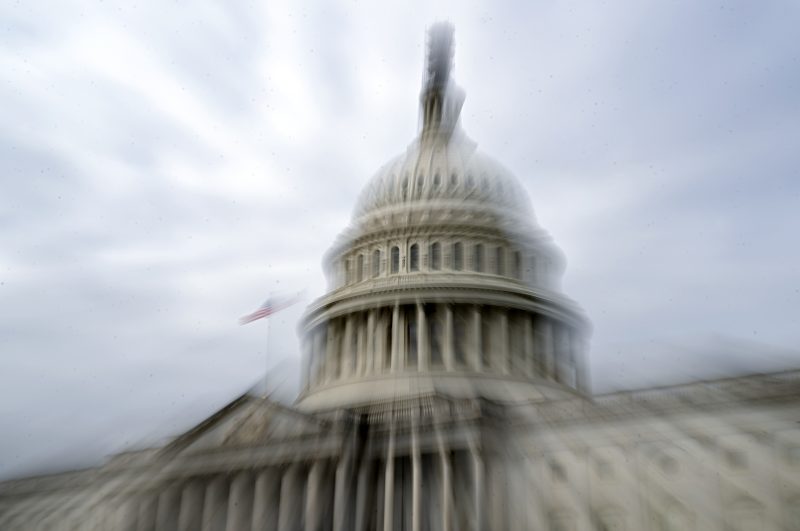A previous version of this article incorrectly stated that the Rep. Charles Wilson who was censured was depicted in the 2007 film ‘Charlie Wilson’s War.’ The lawmaker portrayed in the film was Rep. Charles N. Wilson (D-Tex.); Rep. Charles H. Wilson (D-Calif.) was censured. The article has been corrected.
Rep. Marjorie Taylor Greene’s (R-Ga.) motion calling for the censure of Rep. Rashida Tlaib (D-Mich.) is, like so many things Greene does, an unsubtle effort to amplify fringe-right rhetoric.
Like Greene, Tlaib has been a target of criticism from the opposing party since even before she took office. On multiple occasions, motions of censure have been introduced against her, none successful. But Greene’s stands out, accusing Tlaib not only of antisemitism (a recurring claim) but of “leading an insurrection at the United States Capitol Complex.”
This is an unserious allegation, meant not to actually suggest that Tlaib attempted to overthrow the government with her participation in a protest on Capitol Hill last month but, instead, to minimize the attack at the Capitol on Jan. 6, 2021 by equating that riot with the more-recent protest calling for a cease-fire in the Israel-Gaza war.
As CNN’s Jake Tapper put it in calling out Greene’s motion as opportunistic, “antisemitism is not a cudgel to be used against people for political points, nor is Islamophobia or racism or anti-gay behavior or misogyny or any other kind of bigotry.” (He also noted Greene’s own track record of antisemitic rhetoric.)
But this is the moment we’re in. It’s not just that politicians on Capitol Hill — and in particular the House — disagree. It’s that they frame that disagreement as their opponents being unfit to serve or as disrespecting the institution itself. It’s why censure motions are booming, often centered on newer members of the chamber.
Greene is very familiar with such motions. She’s been the target of more than one herself. In fact, she’s one of a number of sitting legislators, from both parties, who have seen censure motions introduced against them. Two such motions have passed: one against Rep. Paul A. Gosar (R-Ariz.) in 2021 and another against Rep. Adam B. Schiff (D-Calif.) this year. Gosar’s followed his sharing an altered anime video on social media showing him attacking prominent Democrats. Schiff’s was centered on claims he had made about President Donald Trump.
Censure motions used to be rare. There were two in 1979 and 1980, one targeting Rep. Charles Diggs (D-Mich.) following his conviction on charges of graft and the other targeting Rep. Charles Wilson (D-Calif.).
In the early 1980s, two legislators were censured following their involvement in the congressional page scandal. In all four cases, the censures followed the work of House investigatory committees. The motions to censure came from the Democratic heads of the committees.
Then there was a lull until about 15 years ago. Former New York congressman Charles B. Rangel (D) was censured in 2010 following ethics violations. That, too, came from the Democratic chair of the Standards of Official Conduct committee.
In recent years, though, there’s been a flood. Generally, these are motions introduced by one member targeting another. At times, they come from congressional leaders; then-House Minority Leader Kevin McCarthy (R-Calif.) targeted Rep. Maxine Waters (D-Calif.) in 2021. Generally, though, they’re attacks between members of Congress that progress no further than the introduction of the motion.
From 1980 to 2019, there were nine motions focused on censure or supporting censure motions. From 2020 to now, there have been 35. That is slightly inflated, including two centered on Gosar and each of Rep. Anna Paulina Luna’s (R-Fla.) four, evolving motions to censure Schiff, but the difference is still stark.
It’s important that a lot of the recent motions have come from legislators such as Greene and Luna. Rep. Matt Gaetz (R-Fla.) has introduced such motions, as have Rep. Andrew Ogles (R-Tenn.) and Rep. Michael Waltz (R-Fla.). Each of these legislators joined the House in 2016 or later — the Trump era.
You can see the difference in tenure in the House between the two parties. A lot of the new members of the Republican caucus represent districts won by President Biden in 2020, a reflection of the shift in the 2022 midterms. But a lot sit at the top of the diagram below, representing some of the more extreme ideological positions in the caucus. That includes Ogles, Greene, Gaetz and Luna.
These are Trump-allied legislators who have not been on Capitol Hill for long, not people steeped in the sorts of tradition that in the past have fostered collegiality.
The Democrats who introduced censure motions in recent years have generally had longer careers in Washington. The legislators targeted by those censure motions include Greene (for past comments about Democratic legislators), Rep. George Santos (R-N.Y.) (for misrepresenting his background on the campaign trail) and Ogles (same).
Censure motions have become another partisan cudgel, particularly in the hands of relatively new, right-wing members of the Republican caucus. Like threats to impeach, censure motions are a way to escalate the sense of anger that drives the fundraising and attention that fuel the political economy. So they keep coming.

